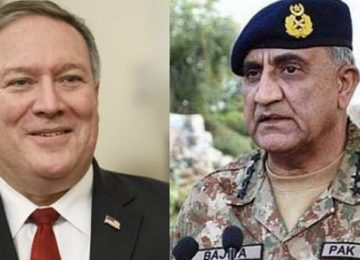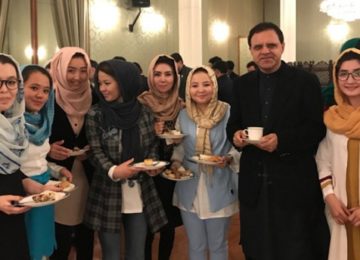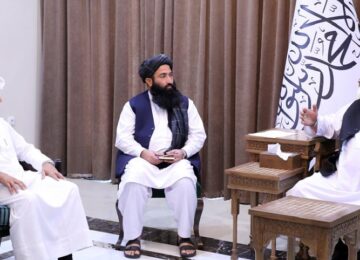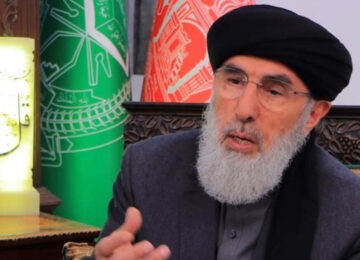The Trump administration says it has everything it needs to succeed in Afghanistan, but it also has a limited time to prove that it’s right.
The war in Afghanistan will be decided in 2018, when a new military-heavy U.S. administration in Washington will prove whether its plan will be enough to overcome entrenched battlefield obstacles and convince skeptics that it is capable of putting an end to America’s longest conflict.
Armed with a new strategy and renewed support from old allies, the Trump administration now believes it has everything it needs to win the war in Afghanistan. Top military advisers all the way up to Defense Secretary Jim Mattis say they can accomplish what two previous administrations and multiple troop surges could not: the defeat of the Taliban by Western-backed local forces, a negotiated peace and the establishment of a popularly supported government in Kabul capable of keeping the country from once again becoming a haven to any terrorist group.
But they face sharp criticism from politicians and populists at home and from some of America’s staunchest allies abroad, who believe the U.S. is sinking into a “forever war” based around a strategy that is too military-focused and ill-prepared to overturn endemic systems of corruption and patriarchy in Afghanistan.
And what limited patience the Trump administration has secured will only see it through next year, when it will have to prove that this new strategy is working and that a plan that has satisfied U.S. and allied defense chiefs – for now – is anything more than misguided delusion.
“There is a thread of branding every year as crucially important. 2018 will be different from others,” Czech Army Gen. Petr Pavel, the top military officer for NATO policy and strategy, told U.S. News on the sidelines of an international security conference in Halifax, Nova Scotia, earlier this month.
The Trump administration released a new strategy for all of South Asia in August, which Mattis explained to eagerly awaiting NATO partners at a gathering of allied defense chiefs here earlier in November. It accounts for a surge of almost 4,000 more American forces and new rules of engagement that allow them to more aggressively attack the Taliban and other extremists, as well as go after their sources of revenue and previously inaccessible hideouts in places like neighboring Pakistan.
In addition to this plan, Pavel, chairman of the NATO Military Committee, is focused on the 2018 Afghan parliamentary elections – the next demonstration of whether democracy is beginning to take root in the developing country, as well as the 2019 presidential elections, where top Afghan leaders hope to avoid a repeat of the awkward power-sharing arrangement that resulted from the last nationwide vote.
And he stressed the importance of a new narrative for defeating the Taliban, one of forcing them through a surge in NATO troops to return to the negotiating table, rather than trying to turn over responsibility to fledgling Afghan forces to defeat the insurgent network militarily.
This new approach by the U.S. was greeted warmly by its allies in NATO, who pledged 3,000 more troops at their summit here to add to the 13,500 allied forces in Afghanistan for the train, advise and assist mission. Half of those are Americans, part of another 7,000 troops that also conduct and support counterterrorism operations . The full complement of forces the U.S. requested from NATO has not yet been met, though officials say they expect contributing countries to finalize their commitments by early next year.
“We’ll stay there as long as we deem it necessary to stay there,” NATO Secretary General Jens Stoltenberg said at the Brussels summit. “We have been there for 16 years and NATO allies and partners continue to provide troops and funding to the Afghan forces. They do this because they see that stability in Afghanistan is important for their own security.”
Some also see contributing to Afghanistan as integral for ensuring domestic security. Latvia for example, the former Soviet nation now one of the newest members of NATO, is sending one new special forces group to help with the Afghan training mission.
“We have to contribute in order to receive when we need support for us,” Latvian Secretary of State for Defence Janis Garisons says, citing the potential need for alliance support were Russia or another adversary to attack Latvia and trigger NATO’s collective-defense agreement. So far, Latvia has provided 100 percent of what the U.S. has asked of it, Garisons says.
But other close partners are not so optimistic about the outcome of their efforts. They join a chorus of U.S. political leaders critical of another element of the U.S. plan that hinges withdrawal on victory, not on timelines, which they fear only further entrenches America into an unwinnable conflict.
“It seems hopeless,” Finnish Minister of Defense Jussi Niinisto told U.S. News earlier this month amid a similar public debate in Finland regarding continued support for the war.
Finland, while not a member of NATO, coordinates closely with the alliance and has contributed forces to the war in Afghanistan since it began in 2001. Although it is not dedicating large numbers of troops compared to countries like the U.S., U.K. or Georgia, it has deployed proportionately high commitment of special operations forces and trainers for a conflict to which it is not bound by alliance.
Niinisto was hosting a little-known gathering of north European defense chiefs known as The Northern Group, which Mattis attended shortly before traveling to Brussels for the NATO meeting where he would outline the new U.S. strategy.
“But if the Afghan nation will find a suitable leader which will unify the country, they will have hope,” Niinisto added. “Now it doesn’t seem that way.”
Indeed many of the problems facing Afghanistan derive from public distrust of government and federal officials, many of whom practice wide-ranging corruption. A U.S. inspector general report for the country described federal corruption as a “serious and complex threat to the viability of the Afghan state” that likely accounts for billions of dollars in lost federal revenue.
“The debate is a legitimate one, but also there are certain realities we have to take into account,” says Abdullah Abdullah, who serves as CEO of Afghanistan, a power-sharing position created in the aftermath of the 2014 election to break his electoral deadlock with political rival Ashraf Ghani, who became president. “You cannot wish away threats that are threats not just to the people of Afghanistan but rather to global peace and security. I wish that was possible.”
Hope for democracy to take root in Afghanistan hinges on parliamentary elections next year, followed by another presidential election the year after. Expectations for fair elections to take place were undercut earlier this month when the Afghan Independent Election Commission announced it had fired its chairman due to a loss in confidence from Ghani and international donors.
Rather than say whether he believes the outcome of the last presidential election has proven successful for Afghanistan, Abdullah prefers to say it is “unique.”
“Governance has its own challenges even without power-sharing arrangements,” he told U.S. News at the Halifax forum. “We are committed, both President Ghani and myself, to the priorities of the people. We will do our best to deliver.”
It requires a lot of work, he says, and both he and Ghani are committed to that.
Yet even if the central government is able to secure the confidence of the Afghan people, and carry out viable elections, they may lose faith in their military’s ability to defeat the Taliban and keep them safe.
Suffering from a steady drawdown in U.S. support in the latter half of the Obama administration, inexperienced and underprepared Afghan troops saw record-high casualties in recent years, totalling more than 2,500 from January to May of this year, the same rate as last year. That accounts for a staggering and unsustaining 20 combat deaths per day, far exceeding the average 1.3 American deaths at the height of the war in Afghanistan. The Afghan and U.S. governments have ceased releasing these figures publicly.
One of the principal causes of the high death rate is the Afghans’ inability to access and rescue their wounded comrades on the battlefield, a highly technical process known as “medevac” that Western countries like the U.S. have perfected but Afghanistan is far from mastering. Currently, its aircraft can only move troops once they’ve been taken to a field hospital and stabilized. And by policy, U.S. pararescue and medevac crews only respond to injured Afghans who are embedded with U.S. forces, not those who are conducting patrols on their own, defense officials say.
Afghanistan’s ability to train its helicopter crews to mount these rescues on their own suffered another setback when the U.S. decided to supply the Afghans with the much more highly advanced UH-60 Blackhawk helicopters instead of the cheaper and less complex Mi-17 Russian-made helicopters, which Congress has pressured the Pentagon to stop purchasing. The Afghan military is currently using four UH-60s, but only for daytime and non-combat missions, ahead of 159 more to arrive in the coming years.
As most combat commanders would agree, soldiers will likely not venture out into danger if they know there’s no hope of saving them from bleeding out from an injury.
Army Gen. John Nicholson, the top general for the war in Afghanistan, says the new strategy and injection of more U.S. forces will help bring these numbers down.
“The No. 1 thing we can do to help avoid casualties is to improve the leadership,” Nicholson told a small group of reporters attending the NATO summit this month. “The second is tactics: get away from static checkpoints and into offensive [operations]. The majority of these casualties are lost in defensive fights on small checkpoints in remote areas. What we’re encouraging our Afghan teammates to do is to reduce their checkpoints, and get more of their forces onto an offensive posture.”
Nicholson says the small, but growing cadre of Afghan commando units has adopted this strategy and has proportionately lower casualty rates, despite conducting 70 percent of offensive operations. Overall casualties have dropped by 20 percent under the new strategy, he says.
“It’s not because they had medevac, but because they’re on the offensive. That’s why we’re doubling the number of commandos,” he says.
In the aftermath of the NATO summit, Nicholson and Pavel say the U.S.-led coalition will by the beginning of 2018 have all the forces it needs to carry out the mission, though some specialities remain understaffed, including new schools to train the Afghan police and non-commissioned officer corps. Nicholson said the U.S. would likely deploy contractors for those roles if it is unable to find a partner to do so.
But the U.S. has already begun demonstrating some of the new authorities it secured under Trump. Earlier this week it for the first time directly targeted the Taliban’s illicit and highly lucrative opium trade.
Nicholson told reporters in the aftermath of these strikes that his goal for the next two years is to get 80 percent of the country back under control of the central government and no more than 10 percent of the country contested by Taliban control.
“Why two years? Because this is when we’re doubling the size of the Afghan commandos. We’re continuing to increase the size of their air force. Of course, they’ll have U.S. combat enablers provided through the U.S. authorities. So this will help their offensive operations,” he said.
For the general and his superiors back in Washington, however, they’ll have limited leeway to prove whether the time they’re asking for will be any different than any previous instance over the last 17 years of U.S. commanders’ asking for just a few more troops and a little more time to secure victory.
This article originally appeared in U.S. News on November 27, 2017. Original link.
Disclaimer: Views expressed on this blog are not necessarily endorsed or supported by the Center for Research and Security Studies, Islamabad.








